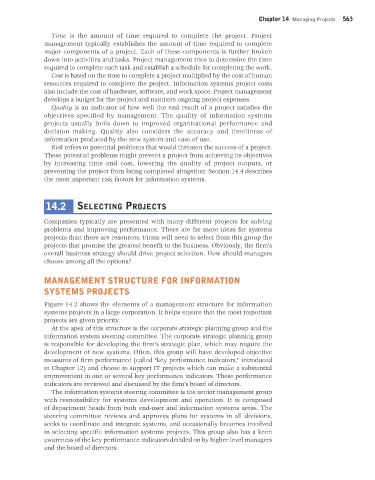Page 564 -
P. 564
Chapter 14 Managing Projects 563
Time is the amount of time required to complete the project. Project
management typically establishes the amount of time required to complete
major components of a project. Each of these components is further broken
down into activities and tasks. Project management tries to determine the time
required to complete each task and establish a schedule for completing the work.
Cost is based on the time to complete a project multiplied by the cost of human
resources required to complete the project. Information systems project costs
also include the cost of hardware, software, and work space. Project management
develops a budget for the project and monitors ongoing project expenses.
Quality is an indicator of how well the end result of a project satisfies the
objectives specified by management. The quality of information systems
projects usually boils down to improved organizational performance and
decision making. Quality also considers the accuracy and timeliness of
information produced by the new system and ease of use.
Risk refers to potential problems that would threaten the success of a project.
These potential problems might prevent a project from achieving its objectives
by increasing time and cost, lowering the quality of project outputs, or
preventing the project from being completed altogether. Section 14.4 describes
the most important risk factors for information systems.
14.2 SELECTING PROJECTS
Companies typically are presented with many different projects for solving
problems and improving performance. There are far more ideas for systems
projects than there are resources. Firms will need to select from this group the
projects that promise the greatest benefit to the business. Obviously, the firm’s
overall business strategy should drive project selection. How should managers
choose among all the options?
MANAGEMENT STRUCTURE FOR INFORMATION
SYSTEMS PROJECTS
Figure 14.2 shows the elements of a management structure for information
systems projects in a large corporation. It helps ensure that the most important
projects are given priority.
At the apex of this structure is the corporate strategic planning group and the
information system steering committee. The corporate strategic planning group
is responsible for developing the firm’s strategic plan, which may require the
development of new systems. Often, this group will have developed objective
measures of firm performance (called “key performance indicators,” introduced
in Chapter 12) and choose to support IT projects which can make a substantial
improvement in one or several key performance indicators. These performance
indicators are reviewed and discussed by the firm's board of directors.
The information systems steering committee is the senior management group
with responsibility for systems development and operation. It is composed
of department heads from both end-user and information systems areas. The
steering committee reviews and approves plans for systems in all divisions,
seeks to coordinate and integrate systems, and occasionally becomes involved
in selecting specific information systems projects. This group also has a keen
awareness of the key performance indicators decided on by higher level managers
and the board of directors.
MIS_13_Ch_14_global.indd 563 1/17/2013 2:31:58 PM

